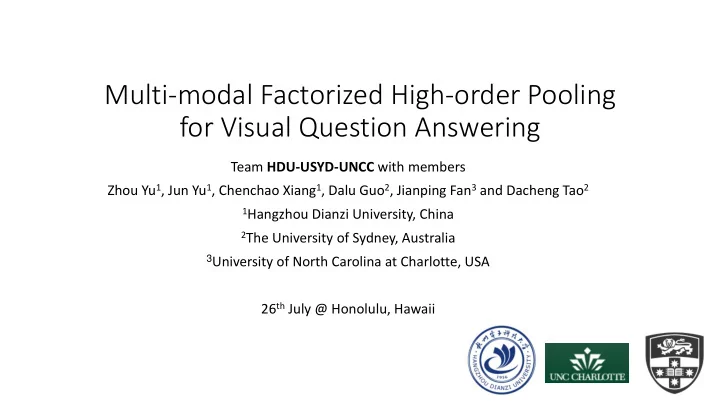

Multi-modal Factorized High-order Pooling for Visual Question Answering Team HDU-USYD-UNCC with members Zhou Yu 1 , Jun Yu 1 , Chenchao Xiang 1 , Dalu Guo 2 , Jianping Fan 3 and Dacheng Tao 2 1 Hangzhou Dianzi University, China 2 The University of Sydney, Australia 3 University of North Carolina at Charlotte, USA 26 th July @ Honolulu, Hawaii
The VQA Problem • The Problem • Given an image and a free Q: What s the question(in free text) about the color of the sign? image, output a textual answer. VQA A: Red Model • The Core Components • Multi-modal feature fusion • Co-Attention Learning
Multi-modal feature fusion • Common-used first-order linear pooling model • Concatenation • Summation • Second-order bilinear pooling • MCB[1]: the champion of VQA-2016, very effective and converge fast , but need high- dimensional output feature to guarantee good performance. • MLB[2]: slightly better performance than MCB with compact output feature but converge slowly . • MFB (ours): much better performance than MCB and MFB , enjoy the both the merits of fast convergence and compact output feature simultaneously. • High-order pooling • We extend the bilinear MFB to a high-order pooling model MFH with cascading several MFB blocks
Multi-modal Factorized Bilinear Pooling (MFB) • Formulation where 𝑦 ∈ ℝ 𝑛 , 𝑧 ∈ ℝ 𝑜 are the multi-modal features, 𝑨 𝑗 ∈ ℝ is i -th output neuron. 𝑉 𝑗 ∈ 𝑗 ∈ ℝ 𝑜×𝑙 are the factorized low-rank weight matrices. k is the rank or the factor ℝ 𝑛×𝑙 , 𝑊 number. To output 𝑨 ∈ ℝ 𝑝 , three-order tensors 𝑉 = 𝑉 1 , … , 𝑉 𝑝 ∈ ℝ 𝑛×𝑙×𝑝 , 𝑊 = 𝑊 1 , … , 𝑊 𝑝 ∈ ℝ 𝑜×𝑙×𝑝 are to be learned. • Simple implementation with off-the-shelf layers • Fully-connected • Sum pooling (slightly modified from avg. pooling), • Elementwise-product • Feature normalizations (power & L2)
From Bilinear to High-order Pooling • Motivation • Model more complex (high-order) interactions better capture the common semantic of multi-modal data. • Multi-modal Factorized High-order Pooling (MFH) • MFB module is split into the expand and squeeze stages. • The expand stage is slightly modified to compose p MFB blocks (with individual parameters) • p =2 in our experiments
Network Architecture • MFB/MFH with Co-Attention Learning The self-attentive Question Attention module brings about 0.5~0.7 points improvement
Experimental Settings • Image Features • 14x14x2048 res5c feature extracted from pre-trained ResNet-152 model with input image resizing to 448x448 • Question Features • Single layer LSTM with 1024 hidden units. • # of Image & Question Glimpses (Attention maps) • {1,2} glimpses for Question Attention ( 𝑅 𝑏𝑢𝑢 ), {1,2,3} glimpses for Image Attention ( 𝐽 𝑏𝑢𝑢 ). The combinations different #. 𝑅 𝑏𝑢𝑢 and #. 𝐽 𝑏𝑢𝑢 lead to different models with diversity. • Training strategy • Adam solver with base learning rate 0.0007, decay every 4 epochs with exponential factor 0.25. Terminate training at 10 epochs (usually obtain the best result on 9 th epoch). • Visual Genome dataset are used for training some models.
Results on VQA-1.0 and VQA-2.0 datasets • Results on VQA-1.0 (test-standard) with model ensemble Observations: • MFB outperform the MCB and models with 1.5~2 points. • Results on VQA-2.0 (VQA Challenge 2017) • MFH models are about 0.7~0.9 points higher than MFB models steadily. With an ensemble of 9 models, we achieved the second place (tied with another team) on the Test- challenge set Leaderboard: http://visualqa.org/roe_2017.html
Effects of the Co-Attention Learning • Image and question attentions of the MFB+CoAtt+GloVe model
Thanks for your attention! • References [1]. Fukui et al., Multimodal compact bilinear pooling for visual question answering and visual grounding, CVPR 2016 [2]. J. Kim et al., Hadamard product for low-rank bilinear pooling. ICLR 2017 • Code and pre-trained models for MFB and MFH are released at • https://github.com/yuzcccc/mfb • Our Papers : • The MFB paper is accepted by ICCV 2017: https://arxiv.org/abs/1708.01471 • The extended MFH paper is under review : https://arxiv.org/abs/1708.03619
Recommend
More recommend